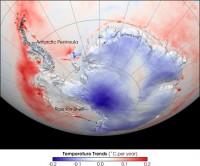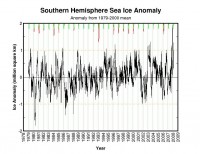By Joseph D’Aleo, CCM
Last year when Antarctic set a new record for ice extent, it got no media attention. They focused on the north polar regions where the ice set record low levels. This summer when unprecedented anomalous cover continued in the Southern Hemisphere again no coverage. Then this report in the news today. You probably saw it on your favorite network or internet news site (pick one, anyone).
Vast Antarctic Ice Shelf on Verge of Collapse - Latest Sign of Global Warming’s Impact Shocks Scientists
Andrea Thompson Livescience
A vast ice shelf hanging on by a thin strip looks to be the next chunk to break off from the Antarctic Peninsula, the latest sign of global warming’s impact on Earth’s southernmost continent. Scientists are shocked by the rapid change of events. Glaciologist Ted Scambos of the University of Colorado was monitoring satellite images of the Wilkins Ice Shelf and spotted a huge iceberg measuring 25 miles by 1.5 miles (37 square miles) that appeared to have broken away from the shelf. Scambos alerted colleagues at the British Antarctic Survey (BAS) that it looked like the entire ice shelf - about 6,180 square miles (about the size of Northern Ireland)- was at risk of collapsing. The region where the Wilkins Ice Shelf lies has experienced unprecedented warming in the past 50 years, with several ice shelves retreating in the past 30 years. Six of these ice shelves have collapsed completely: Prince Gustav Channel, Larsen Inlet, Larsen A, Larsen B, Wordie, Muller and the Jones Ice Shelf. See MSNBC version of this story here.
Icecap Note: Let’s put this in perspective. The account may be misinterpreted by some as the ice cap or a significant (vast) portion is collapsing. In reality it and all the former shelves that collapsed are small and most near the Antarctic peninsula which sticks well out from Antarctica into the currents and winds of the South Atlantic and lies in a tectonically active region with surface and subsurface active volcanic activity. The vast continent has actually cooled since 1979.

See full image here
The full Wilkins 6,000 square mile ice shelf is just 0.39% of the current Antarctic ice cover (just 0.1% of the extent last September). A very small piece broke off as an iceberg (37 square miles). Then only a small portion of it around 160 square miles partially disintegrated late this February into early March. That represents just 2.67% of the full Wilkins ice sheet and 0.01% of the total Antarctic icecover (0.003% of its level last September), a little like an icicle falling from a snow and ice cover roof. No big deal (unless you are standing beneath it).
And this winter is coming on quickly. Satellite images show the ice has already refrozen around the broken pieces and expanded. In fact the ice is returning so fast, it is running an amazing 60% ahead (4.0 vs 2.5 million square km extent) of last year when it set a new record. The ice extent is already approaching the second highest level for extent since the measurements began by satellite in 1979 and just a few days into the Southern Hemisphere fall season and 6 months ahead of the peak. We are very likely going to exceed last year’s record. Yet the world is left with the false impression Antarctica’s ice sheet is also starting to disappear. See pdf of this story for posting here.

See full image here Source: The Cryosphere Today
One Icecap reader points also to a paper (Glasser et al, 2008) identifying some of the other natural processes that can lead to these ice sheet breaks, in this case Larsen B.
By Christopher Monckton, Third Viscount Monckton of Brenchley
Al Gore no longer gives interviews to the Press except where the interviewer has been carefully pre-selected for his sycophancy and for his lack of elementary knowledge of climate science. Likewise, Gore no longer takes questions from the audience at any public meeting unless he is sure that no one in the audience knows anything of climatology. The interview from which the following list of Gore’s latest scientific errors and
exaggerations was compiled appeared in India Today on 17 March 2008.
Error 1: “‘Global warming’ is a planetary emergency. It is a crisis and we have to find ways to come to an agreement to reduce the carbon dioxide.”
The facts: There is no “planetary emergency”. Nor is there a “crisis”. If there is an “emergency” or a “crisis”, it is certainly not caused by “global warming”. The increase in global temperatures between 1980 and 1998, when “global warming” stopped, was only half of the small increase shown in the official temperature records (McKitrick, 2006, 2007 in press). In the decade since 1998 there has been no statistically-significant increase in global temperature (HadCRUt3, 2008; US NCDC, 2008; RSS,2008; UAH MSU, 2008; etc.). In the seven years since early 2001, the trend of global temperature has been downward at a rate equivalent to more than 0.4degrees Celsius (0.75 F) per decade:

Error 2: “Today we the people of this planet would put another 70m tons of global warmingpollution into the earth’s atmosphere.”
The facts: “Global warming pollution” is Gore’s favorite phrase for “carbon dioxide.” However, CO2 is not a pollutant, but a naturally-occurring gas. Together with chlorophyll and sunlight, it is an essential ingredient in photosynthesis and is, accordingly, plant food. The reconstruction of palaeoclimatological CO2 concentrations below, taken from Berner (2001), demonstrates that carbon dioxide concentration today is almost at its lowest level since the Cambrian era 550 million years ago, when there was almost 20 times as much CO2 in the atmosphere as there is today, without any threat to animal or plant life, and without causing the “runaway greenhouse effect” that Gore likes to mention:

See larger image here. See all ten errors here.
Lord Christopher Monckton, UK, - Third Viscount Monckton of Brenchley was Special Advisor to Margaret Thatcher as UK Prime Minister from 1982 to 1986
By Dr. Roy Spencer in the Energy Tribune
While a politician might be faulted for pushing a particular agenda that serves his own purposes, who can fault the impartial scientist who warns us of an imminent global-warming Armageddon? After all, the practice of science is an unbiased search for the truth, right? The scientists have spoken on global warming. There is no more debate. But let me play devil’s advocate. Just how good is the science underpinning the theory of manmade global warming? My answer might surprise you: it is 10 miles wide, but only 2 inches deep.
Contrary to what you have been led to believe, there is no solid published evidence that has ruled out a natural cause for most of our recent warmth - not one peer-reviewed paper. The reason: our measurements of global weather on decadal time scales are insufficient to reject such a possibility. For instance, the last 30 years of the strongest warming could have been caused by a very slight change in cloudiness. What might have caused such a change? Well, one possibility is the sudden shift to more frequent El Nino events (and fewer La Nina events) since the 1970s. That shift also coincided with a change in another climate index, the Pacific Decadal Oscillation.
The associated warming in Alaska was sudden, and at the same time we just happened to start satellite monitoring of Arctic sea ice. Coincidences do happen, you know that is why we have a word for them. We make a big deal out of the “unprecedented” 2007 opening of the Northwest Passage as summertime sea ice in the Arctic Ocean gradually receded, yet the very warm 1930s in the Arctic also led to the Passage opening in the 1940s. Of course, we had no satellites to measure the sea ice back then.
I am not claiming that all of our recent warming is natural. But the extreme reluctance for most scientists to even entertain the possibility that some of it might be natural suggests to me that climate research has become corrupted. I fear that the sloppy practice of climate change science will damage our discipline for a long time to come. Read more here.
Roy W. Spencer is a principal research scientist at the University of Alabama in Huntsville. His book, “Climate Confusion: How Global Warming Leads to Bad Science, Pandering Politicians and Misguided Policies that Hurt the Poor”, will be published this month.


